Trans Women at DC in the Early 90’s (1992-1994)
With the 90s came the rise of alternative comics at DC. While mainstream comics stayed far away from actual trans characters, sticking to their shapeshifters, five titles, all at DC or DC imprints, actually gave pretty substantial roles to trans characters.
The most famous of these trans characters is probably Wanda in the previously mentioned Sandman series. After we see the murdered and unnamed trans woman in The Doll’s House, we meet Wanda in A Game of You. Wanda is one of the people living in an apartment building with the book’s main character, Barbie. She’s Barbie’s best friend and is in a pretty substantial amount of the book. However, Barbie soon becomes trapped in Dream land and when it comes time to rescue her, Wanda is left behind. The witch Thessaly takes two other women from the apartment building, Hazel and Foxglove, with her, but leaves Wanda behind because, as she’s told by the disembodied face of a man named George in Sandman #35, “It’s because you’re a man. That stuff they did with the uh moon, that was a woman thing.” When Wanda demands recognition that she’s a woman, when she says, “Listen: I’ve had electrolysis. I’m taking hormones. All that’s left is just a little lump of flesh; but all that doesn’t matter. Inside I’m a woman,” George replies “She (the moon) doesn’t seem to think so. And to be honest uh well even if you had uh had the operation it wouldn’t make much difference to the moon. It’s chromosomes as much as uh anything. It’s like uh gender isn’t something you can pick and choose as uh far as gods are concerned.”
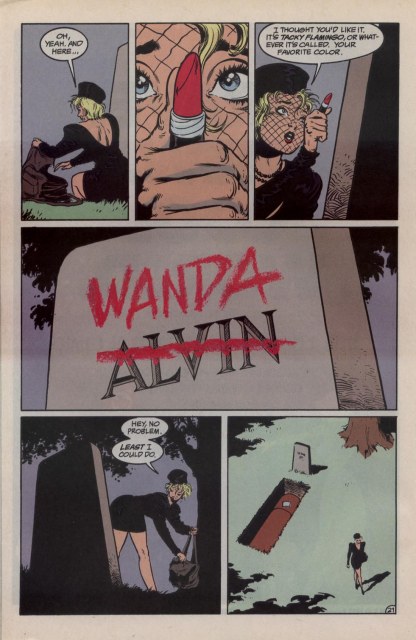
From Sandman #37 with art by Shawn McManus.
Wanda says that the gods can take that and stuff it up “their sacred recta,” but it still remains that even in this world of fantasy, where we have gods and demons and witches, the supernatural forces that govern the universe are, for some reason, stuck on the Western gender binary. A little later in the series Wanda is killed when a storm collapses the apartment building, and her transphobic parents bury her as a man. Barbie then comes by and crosses off the name on her tombstone and writes “Wanda” in red lipstick. Wanda does stand out as one earliest and best examples of an actual trans person in comics, but she also gives many trans readers mixed feelings. Not only does she die a tragic death, as far too many real life trans people do, but she’s also misgendered, by the moon of all things. Trans people can’t even be acknowledged as real women by the gods in fantasy comics.
I mentioned Masquerade earlier, but I want to revisit him here. While it’s true that he was a shapeshifter, and that’s how he transitioned, it does appear that actually was a trans man, making him the first trans man superhero. He was a character in the comic book for the superhero group Blood Syndicate, which was written by Dwayne McDuffie and Ivan Valez, Jr. and was made up of mostly African-American and Latino characters. While another character, Fade, eventually does find out about Masquerade’s gender assigned at birth in Blood Syndicate #10, it seems that he works as a male superhero because that is his idealized version of himself. Also in Milestone comics at the same time as Masquerade was a character named Marisa Rahm. She was in the series Deathwish and was a police Lieutenant and trans woman in a relationship with another trans woman, a sex worker named Dini. Rahm is faced with disgust and discrimination when she starts to transition while a police officer; she eventually defeats a serial killer who is targeting trans women. Another notable thing about Deathwish, and therefore Rahm, is that the miniseries was written by Maddie Blaustein, a trans woman who also worked as a voice actor, perhaps most notably playing Meowth in the American version of the Pokemon cartoon.
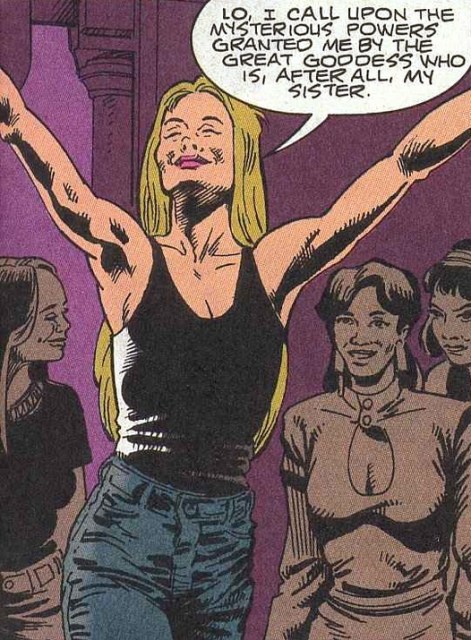
Kate Godwin in Doom Patrol.
Perhaps the biggest marker that real progress was being made in the area of trans representation in comics was the case of Kate Godwin, or Coagula in 1993. Coagula was a member of DC Comic’s off-beat superhero team Doom Patrol, and was not only a trans woman, but was also created and written by a trans woman, Rachel Pollack. She had the power to coagulate and dissolve liquids at will (hence the name) and was bisexual, eventually entering into a relationship with her Doom Patrol teammate, Robotman, who is a human brain in the body of a robot. I talked to Pollack about where her idea for Kate Godwin came from, and how she created the character. She said that she wanted to see someone like her in the comics she loved.
To a large extent I was inspired to write Doom Patrol by the previous writer, Grant Morrison, whose run was brilliant and daring. Morrison had a thing, apparently, for transvestites and drag queens (some variation appeared in almost all his comics at that time), so it seemed an almost obvious step to have an actual trans character. More importantly, this was during one of my trans activist periods, so I was very involved in trans issues. I gave Kate a history of being a [sex worker] and a computer programmer since at that time those were by far the professions most represented in trans women’s lives. Interestingly, the name “Coagula” appears exactly once in the comic, in her story about applying to the Justice League. Other than that, it’s always just Kate (in honor of Kate Bornstein — the Godwin was inspired by my friend Chelsea Goodwin saying she’d always wanted to be a character in a comic — plus Mary Godwin, the maiden name of Mary Shelley, author of Frankenstein, whose mother Mary Wollstonecraft wrote Vindication of the Rights of Women).
I just realized an interesting, and convoluted, connection. At that time, so-called radical feminists were fond of describing people like us as “Frankenstein’s monsters,” men changed into pseudo-women by male doctors to infiltrate the women’s movement and destroy it with their evil male energy. Seriously. I am not making this up. I wish I was.
Pollack said that being able to introduce a trans character like Godwin felt wonderful, “not just because of the external fact of creating a trans woman hero, but also because she made the whole team coalesce, she brought together the story and its implicit themes — body issues and extreme outsiders learning to accept themselves and embrace life.”
Funnily enough, a year after he left the title and Pollack wrote Kate Godwin into Doom Patrol, Morrison introduced his own trans woman character, Lord Fanny, into his Vertigo series The Invisibles. Fanny was a shaman in Brazil, who was assigned male at birth, but was raised as a girl by her grandmother, who wanted her lineage of (female only) witches to continue. She was, confusingly enough, a shaman for an Aztec goddess, despite being from Brazil and not Mexico. Lord Fanny could also potentially belong in the Not-Quite-Trans category, as she was forced to be a girl by her grandmother. Outside of DC, Guy Davis and Gary Reed’s Baker Street, a punk rock take on Sherlock Holmes released by Caliber Comics had a character named Sam who was revealed to be trans in its second volume.
The Beginning of the Change (2005-2013)
Trans representation in comics fell pretty dormant for around a decade. As Pollack told me, this was probably “because the general society just wasn’t ready — not just ready to accept us as real, but even just to see that we exist.” After the spate of trans women appearing in comics in the early nineties, the next significant trans character was perhaps not really trans at all.
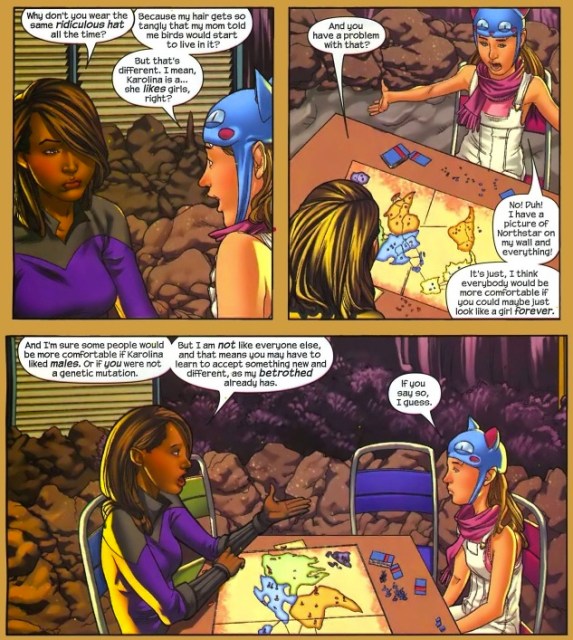
Xavin and Molly having a discussion about gender in Runaways #22 with art by Adrian Alphona.
Xavin, as I mentioned earlier, was a shapeshifting Skrull who alternated between presenting as male and female and who made her debut in Brian K. Vaughan’s series Runaways in 2005. She was usually in her female form when with Karolina Dean, a lesbian character who Xavin was sent to earth to marry in order to end a galactic war. While she spends perhaps the majority of her time in the series in her male form, several times she indicates that she feels more female. When she and Karolina are getting married, she tells her “I’m only a groom for my fellow Skrulls; Karolina, deep down I’m a blushing bride like you.” There’s also a scene in Volumen 8 of the series where she and Karolina are arguing, causing Xavin to lose control of herself and she unconsciously shapeshifts into her “female” form, causing Karolina and Molly, another member of the team, to be excited that Xavin’s female form is her default. A confused and somewhat defeated Xavin replies, “I didn’t realize that was in doubt.” Ultimately, I think the most reasonable reading of Xavin is as genderfluid.
In Morrison’s 2005 DC series Seven Soldiers, he took the character Shining Knight, who had previously been a cis man, and remade him into a woman named Ystina who disguised herself as a man in order to fight as a knight. The 2011 fantasy series Demon Knights, written by Paul Cornell, takes this another step closer to actual trans and intersex representation. In Demon Knights #14, in 2012, Shining Knight has a conversation with Exoristos, a woman with ties to the Amazons who has feelings for him, and says “I think you like one… aspect of who I am. But I’m the other too. I was born this way. I’ve kept saying, whenever anyone asks. I’m not just a man or a woman. I’m both.” While Cornell was initially reluctant to label Sir Ystin, he later tweeted “It’s great that a DC character can come out as transgender and it not excite much comment. Very refreshing.” It’s still not clear, though, if this means Sir Ystin is a trans man, bigender, intersex or some combination of those identities.
Then, on April 10, 2013, in Batgirl #19, probably the biggest moment in American trans comics history happened. Alysia Yeoh, Batgirl’s bisexual, Singaporean-American activist roommate came out as trans.
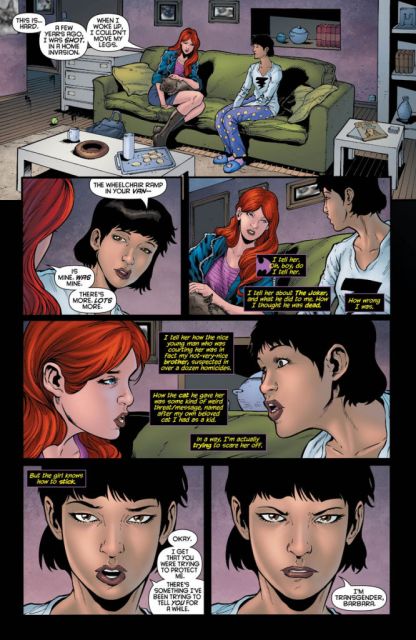
Alysia coming out to Barbara Gordon from Batgirl #19.
Before this Alysia had been a big part of Barbara’s life, and was, at that time, probably her closest friend. The two were having a conversation where Alysia told Barbara that she was worried about her, and so Babs tells her that she used to be paralyzed, that she was shot by The Joker, that her brother is a serial killer. Alysia responds to Barbara’s sharing of these intimate secrets by sharing her own. In one of the most touching moments in comics that year, Barbara hugs Alysia and tells her to call her “Babs,” saying “The people I love call me Babs.”
This moment marked the first time we saw a non-fantasy, non-science fiction, human trans character in a non-mature, mainstream comic book. At the time, Batgirl was DC’s 17th highest-selling title, this was a big moment. It was the big moment trans readers had been waiting for. Then Batgirl writer and Alysia’s creator, Gail Simone told me that she created the character because, as a woman, she knows what it’s like to look for characters you can relate to and not be able to find them.
When I was a little girl, there was literally no one who supported the fact that I read comics. I mean, there was no support system and my few interactions with other comics readers were actually a bit hostile. That stuck with me. I always dreamed of a time when comics opened up and said, simply, “You are welcome here.”
So when I ended up writing comics, I made a concentrated effort to create fun new female characters, it was really important to me, because I knew there were a lot of little girls out there who would love this medium if given half a chance. But then I started going to conventions, and I realized the shallowness of my philosophy. Here we had this readership that was incredibly, remarkably divers…people of every age, gender, body type, sexuality, ethnicity and more, and it was very clear that comics hadn’t changed much in decades. Where were the characters that represented them?
She was also inspired by fans she met, trans readers who told her that they didn’t really have any heroes to look up to in their favorite comics.
Tokenism isn’t enough, we can’t have one character and say, “okay, good, we’re done, let’s move on.” I had met and spoken with so many trans readers, smart lovely people who loved comics, but had to appropriate characters that were, you know, robots or aliens in comics because that was the closest thing to any kind of trans representation. It bothered me a lot. I know there’s always a danger of allies jumping in and sucking all the oxygen away from the conversation, but it bothered me and I wanted to say that thing, “You are welcome here,” to everyone, not just little red-headed farm girls like I had been.
Simone initially thought that she was going to face pushback from her editors about introducing a trans character. After all, if it was so accepted, why weren’t other writers already introducing trans characters into their books?
So I got the help of some wonderfully brilliant and generous trans readers, and I made a lunch appointment to speak with my DC boss, Dan DiDio at San Diego. I was ready to fight for Alysia to be trans in Batgirl. It was important. I made a list of reasons why it should happen, and in a key book, a BAT book. So I came loaded for bear.
I give my pitch to Dan, expecting an argument. Instead, he pauses for a moment, and just says, “Okay, but I don’t want it to be exploitative. Make it honest.” And it really took the wind out of my sails, because I had this argument READY TO GO. But Dan has honestly always been great about LGBTQ characters, I needn’t have worried.
While DC Comics was supportive, others weren’t quite so happy about a trans character who was Batgirl’s best friend. Many readers, though, and especially trans readers, latched onto the character, who was already well-liked, and made her into a quick fan favorite.
We expected backlash. And there was some, I still get hate mail about it once in a while. A couple of late night talk show hosts lost my respect by making crappy jokes about it (fuck you, Conan O’Brien). But honestly, the truth of the matter is that the positive response was overwhelming, and completely overshadowed the angry weirdos. We got a ton of mail, almost all of it positive. And, I am happy to say that Alysia became by far the most popular character in the book, barring Batgirl herself. No matter how much room we gave her, people wanted more. When I left the book, Alysia was shuffled out of town off-panel to focus on a new cast, but the readers demanded her back. She’s that popular.
That made me very happy. And I again thank the many trans readers who helped me with important information and resources. Bless them all.
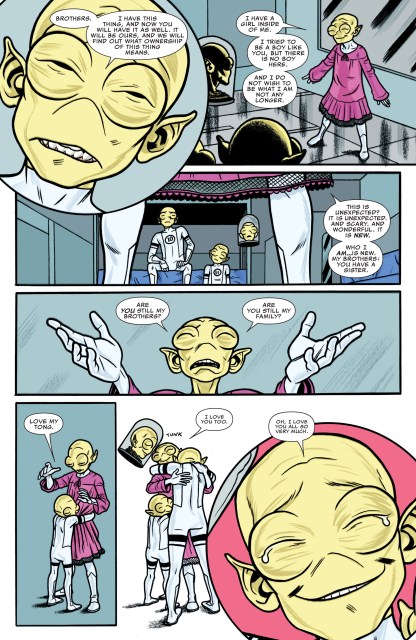
From FF #6 with art by Joe Quinones.
One lesser-known trans character that was introduced just two weeks after Alysia was in Matt Fraction and Mike Allred’s FF is a young Moloid named Tong. The Moloids are a subterranean race of humanoids who were originally created in 1964 by Stan Lee and Jack Kirby and four of them, including Tong, were members of the Future Foundation. This was a very strange book, and Tong isn’t technically human, but she is humanoid, and despite the somewhat odd way she talks, the way she came out as trans rings very true. In FF #6 she shows up wearing a pink dress and explains to her brothers, “Brothers. I have this thing, and now you will have it as well. It will be ours and we will find out what ownership of this thing means. I have a girl inside of me. I tried to be a boy like you, but there is no boy here. And I do not wish to be what I not any longer. This is unexpected? It is unexpected. And scary. And wonderful. It is new. Who I am… is new. My brothers: You have a sister. Are you still my brothers? Are you still my family?” The way Tong’s brothers embrace her and tell her that they love her, and the fact that she’s a child make this page amazingly touching. Later in the comic, Tong and is walking hand-in-hand with brothers wearing her new dress walk past the adults in charge of the Future Foundation. Ant-Man looks and says “Is that a thing we’re doing now?” while Miss Thing and She Hulk smile and respond “Good for her,” and “Okay.” Unfortunately, FF didn’t last much longer and Tong hasn’t really been seen since.
Next: Revolutionary representation from Image Comics
Pages: 1 2 3See entire article on one page



This was fascinating to read. Thanks for showing us how far we’ve come in terms of trans representation.
Mey, this is incredible.
Really satisfying to read through too!
Comics, especially away from the Big Two, are such an exciting place to be in the past few years: it’s a momentum, with a new generation of creators, that feels unstoppable.
And within the Big Two, the love and sincerity behind the epic fantasy-romance that Angela and Sera are shaping up to be is just extraordinary; and the tragedy, the ups and downs, the heart in your mouth genre drama and silliness, if you will, feels like something I can expansively embrace without the fear that who Sera is will be betrayed. Or that the relationship between these two women will be undersold. When you have to be so guarded in your life, it’s so nice to be able to just float in breathy-sighs and giggle a bit.
Wow. This is a masterwork, Mey!
This is so rad! I can’t wait to see the continuation!
Could I also recommend the comic Storm Dogs from Image, by David Hine and Doug Braithwaite?
http://www.bleedingcool.com/2013/05/08/gender-sex-work-and-going-beyond-diversity-natalie-reed-storm-dogs-5-print/
Oh, cool, i hadn’t heard about this and didn’t see anyone else talking about this as an example of trans representation. Thanks for pointing me toward it!
This is amazing! You’re so knowledgeable about comics, we’re all lucky to get to read your writing about them.
This is an awesome article, Mey! Thank you so much for the mention. :D One thing I was surprised wasn’t included: ‘Deathwish’ was created and written by Maddie Blaustein, a trans woman, who is sadly no longer with us. She was also the voice of Meowth from Pokemon!
Thanks! And Sophie, you’re totally right! I can’t believe I left her out! When I first came up with this idea and was making a list off the top of my head I thought “oh, i need to mention that woman who voiced Meowth” not being able to remember her name or what comic she wrote, but then when it came to actually write it, I somehow left her name off! I’ll add it in right now! Thanks
Fantastic, Mey!
Samuel Delaney’s takedown of that Sandman comic in his introduction to A Doll’s House is the most beautiful damning with faint praise I have ever read.
Nice overview Mey, you may also want to look at Welcome Back (issue #3 out this week) which features two soldiers who are reincarnated over and over into different bodies, both male and female. Also highly recommended is Flutter from 2013 about a girl with powers who meets a girl she likes and shape-changes into the girl’s ideal boy. It gets very complicated for her after that, but the first volume is very good. There is also a second volume that came out recently, but I haven’t read that yet.
For this week there are a few other comics with female or LGBT lead characters that everyone might be interested in.
– Clean Room #2 by Gail Simone. A woman is trying to bring down a self-help guru who she believes killed her fiance. Too early to tell how this one will turn out.
– Wayward #11. This is an interesting series set in Japan and delves into a lot of Japanese mythology. 5 teenagers with mystical powers are the lead characters and there have hints of romance between two of the girls.
– Vader Down #1. Marvel’s first Star Wars crossover as the rebels lead by Leia try to take out Vader while Aphra and her droid sidekicks try to rescue him.
– Cognetic #2. The lead character is a lesbian, although her wife and daughter have only been “seen” when she makes a phone call.
– Giant Days #8. I still have to catch up on this one, but I’ve heard it’s good.
– Welcome Back #3.
Here’s a site that lists more pre-2002 (last time the owner updated it) depictions in comics:
http://www.tgfa.org/
THIS RULES!! I was spoiled on Lumberjanes, but that’s okay and actually exciting because I was really hoping for a trans character in that comic and to have it be real just… jadlkfjghagh!! I can’t wait to catch up and then lend the new trade to my young friend (former nanny charge) who loved the first trade and wants to be a Lumberjane.
And wow. This is a masterwork. Thank you for all of your research and dedication! I’m now going to spend the remains of my snow day getting caught up on Lumberjanes, Shutter, and WicDiv.
Oh! And I was super thrilled to learn that Kate Godwin was named for Auntie Kate! What a great tribute to an incredible person!
This is a great article! I didn’t realise Jo from Lumberjanes was trans, and that’s good to hear – though I have to admit it really doesn’t interest me in going back to Lumberjanes.
I’d like to add a comic that’s missing from this, which is Gary Reed and Guy Davis’ excellent Baker Street, which has a trans main character. It’s a little… typical in what happens to her (I won’t say more), but I appreciated her being there all the same and it worked really well for the comic.
Thanks for letting me know about Baker Street!
Wow! Super informative and well written Mey! I learned a lot!
Thank you, Mey! This is wonderful. And I almost tweeted Kelly Sue DeConnick when I finished reading Bitch Planet, vol.1 to ask her if she was going to include trans women in future issues, but I kept going over the character limit in my tweets and gave up, haha. Happy to see I didn’t have to tweet her about it after all!
Wow. Wowowowow, Mey. This is incredible. I don’t even know that much about comics and I enjoyed reading this. In fact, it makes me want to read more comics…The Wicked & The Divine, in particular.
Thank you for this, it’s awesome!
Lord Fanny is a highly problematic character, but I’d categorize her as am actual trans woman. While it’s true her grandmother says she’ll raise the child as a woman to carry on the witch lineage, it’s not accurate to say she forces Fanny, either to be a girl or a witch. Throughout the issue on Fanny’s backstory, Fanny embraces and pursues feminine/witch expression/identity wholeheartedly and of her own volition.
There’s also a point later in the comic series where Morrison almost has Fanny say that genitals don’t determine gender, but he doesn’t commit and her line gets cut off by another character interrupting.
Batgirl and Bitch Planet have been on my to-get list and now I’m dying to read them ASAP! And Rat Queens! ACK!
This is awesome! Thanks for writing this, Mey!
I thought about chiming in with several recommendations for webcomics with trans characters (I’m a big webcomics reader), but now I’m hoping that will be another post…
Wow, some of these entries bring back dubious memories. Kudos on the incredibly comprehensive meta-analysis.
This history is perfect except for the fact that I’M not in it ^_____^
This misses out some 50s comics such as:
TRANSFORMATION
http://pappysgoldenage.blogspot.com.au/2009/10/number-606-no-longer-science-fiction.html
TRANSFORMATION COMPLETED
http://www.gayleague.com/comics-archives/transformation-completed/
also, in Gay Comix:
I’M ME!
http://imgur.com/a/a9koG#0
Fantastic list, thank you for putting it together. While there are certainly issues with Gaiman’s depiction of Wanda in The Sandman, I think some of the criticism is misdirected. Gaiman has stated quite clearly that the reason the Moon refuses to see Wanda as a woman was because he was specifically critiquing transphobia he’d observed in early 90s pagan communities. The effectiveness of that critique, or how it’s interpreted through a modern lens, well, that’s always up for debate.
Excellent!
Thanks for mentioning my Shining Knight. I let the Knight’s exact status remain vague, apart from their statement they were ‘both’, several other references to that effect, and my instructions to the artists, because I didn’t want to exclude *anyone* who identified as trans. It’s all there on the page, though, not something readers have to find in subtext. Good article. I loved Doom Patrol.
What a great article, I’m glad I took the time to read it. I’ve been mildly interested in Help Us! Great Warrior and now that I’ve been informed that there’s a trans woman in it I think I’m going to try it.
Fantastic article. One small quibble though. The picture of the Ultra Humanite that you have in the beginning of the article isn’t from Action Comics #20 nor is the art by. Joe Shuster. I have a scan of the actual page if you wish to use it.
Seems that you conveniently forgot that at the very end of “A Game of You” that Death sees Wanda completely as a woman. I remember Gaiman getting flak for how some random moon Goddess sees Wanda, Gaiman responded by saying that the way Death sees Wanda is what matters and that he agrees with Wanda about Gods and Goddesses sticking it up their sacred rectums. You also act like Gods and Goddesses matter in that series when it’s said over and over again that they only exist because we believed them into being, so how important is a God or Goddess if that is the case.
I also know that “A Game of You” was a catalyst for changing how comic readers saw trans people but I lament that they had to change artists halfway through and the new artist had no idea how to draw a trans person who had been on hormones for a long time.
Not sure if they count as Trans but the character Cloud (who was in reality a personified nebula with amnesia) from the Defenders in the late 80’s was able to manifest their physical form as both biological male and biological female.
Wonderful article!
Point of order though- that panel of the Ultra-Humanite was drawn by Kurt Shaffenburger, who drew Superman (and Superboy) for many decades, starting in the 1950s.
If you are looking for printing services in Ahmedabad, then look no further as we are here to help. Get in touch with us to know more about a wide range of printing services and prices.
Is there any chance of including Coagula from Doom Patrol (first introduced in 1993) by trans creator Rachel Pollack?
As far as I can tell she’s DC’s first actual trans superhero character (as opposed to shapeshifters, body-swaps etc.) and it would be good to see her represented.
Excellent post !
This is the best blog so far
This is best blog.
Skincell Pro is a powerful serum made from natural ingredients. With just a few drops applied to a blemish, the serum works to penetrate to the root of a mole or skin tag.